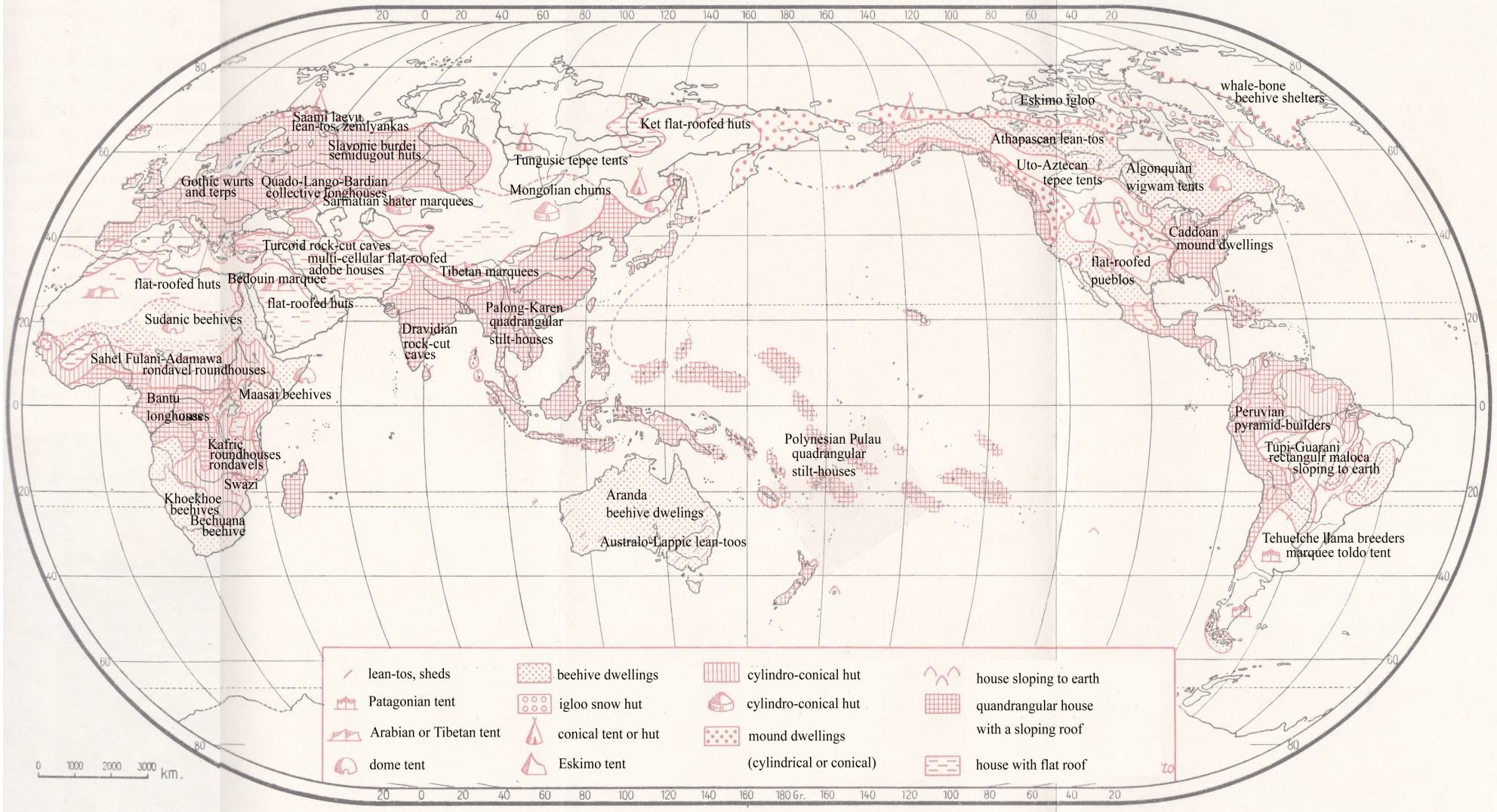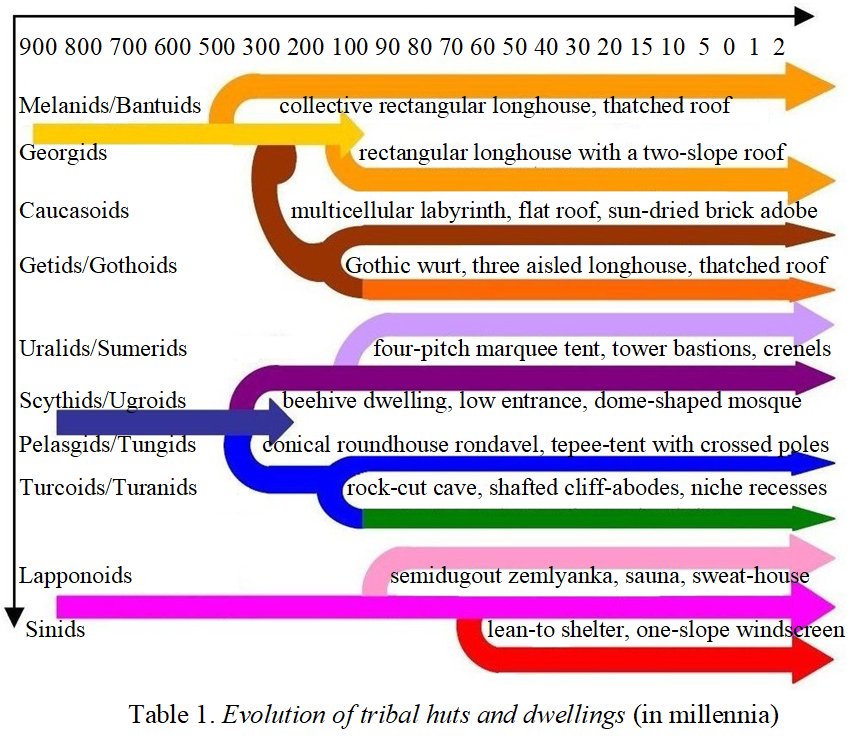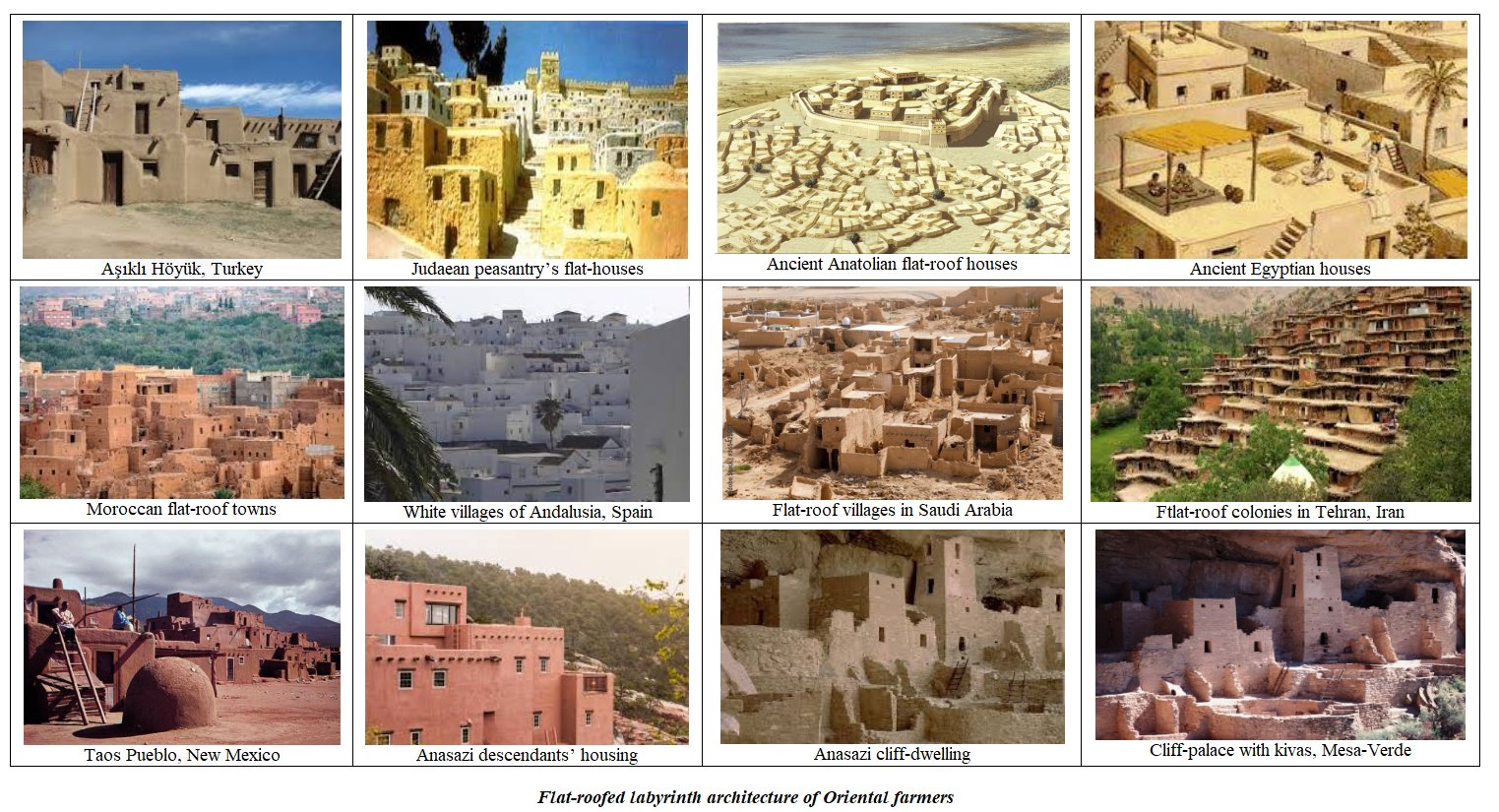|
|
|
||||||||||
|
|
|
||||||||||
|
|
|
|
|||||||||
|
|
|
|
|||||||||
|
|
|
|
|||||||||
|
|
|
||||||||||
|
|
|
||||||||||
|
|
The Ancient Indigenous Architecture of Oriental
Farmers Clickable terms are red on the yellow background |
|
|
||||||||
|
Map 1. Types of human dwellings (after R.
Biasutti) |
||||||
|
|
||||||
|
|
||||||
GENERAL ARCHITECTONICS
·
Evolution of human dwellings · Lakeside Stilt-Dwelling with Crossed Poles |
FOLK ARCHITECTURE § Cliff-Dwellings and Burial Rock-Cut Caves
§ Rectangular
Longhouses Out of Straw and Mud
§
Earth
lodges and Subterranean Sancturaries § Semidugout Zemlyankas of Lapponoid Cremators
|
TYPES OF DWELLINGS
§
Tungusoid teepes,
pile-huts and lake-dwellings
§ Pelasgoid conical rondavel roundhouses§
Megara, palatial
temples and columnal palaces
§
Flat-roofed
labyrinth architecture of Oriental farmers
§
Rectangular wicker longhouses with
thatched roofs
§
Gotho-Frisian
wurts, terps and half-timber longhouses
§
Dome-shaped beehive huts
§
Irregular
multi-peaked marquee nomadic tents
·
Epi-Aurignacian
tepees and pile-dwellings
·
Bascoid Cyclopean megalithic
architecture
·
Megalithic
tombstones and tholoi graves
·
Lapponoids’ lean-to and semidugout pit-house
·
Turcoid dwellings
and burials in rockcut caves
|
ANCIENT SETTLEMENTS §
Lakeland,
marshland, lowland, grassland and desert ecosystems §
Multicellular
labyrinths in arid subtropical lowland §
Tell-sites
in oases of subtropical shrublands §
Multicellular
labyrinths in arid subtropical lowland §
Tell-sites in
oases of subtropical shrublands §
Oppidans:
hillforts towering on high rock promontories §
Getic boroughs:
villages in alluvial lowlands §
Palatial poleis
and cultic spas in seaside harbours §
Straight streets
and alleys of lake-dwellings |
|
||
Tell-Site, Multi-Cellular Flat-Roofed
Labyrinth, Pueblo
Tell-sites. As
the Neolithic peasants applied shifting agriculture, they regularly abandoned
their settlements and returned to them in periodic cycles. When leaving old
homes, they set their houses on fire and furnished the village as a necropolis
of their dead ancestors. After returning, old ruins were pulled down and new
walls were erected on their remains. Every generation of inhabitants elevated
the mound by adding a new storey and so the tell grew high like a
mushroom. Tell Brak in Turkey was 40 metres high, Tepe Gaura in Iran 20 m
high and the Karanovo tell in Bulgaria 12 m high. Most tells in
the Tisza basin were hardly more than 3 metres in height. High tells
were common in Turkmenistan (Anau culture, Namazga Tepe), in Palestine
(Jericho I, -7,800), Assyria (Tell Hassuna), in Caucasus (Tepe Hissar) and
southeast Europe (Karanovo I). The Linear Ware people in Central Europe built
only lower mounds, because free land gave more space for migrations. The
Frisian wurts on sand-dunes seem to be their trueborn heirs in the
outer layout and design. The Arabic word tell
meant a ‘heap, mound’ while the Iranian tepe denoted a ‘hill’. In
Turkmenistan their equivalent was depe, in Egypt such settlements were
referred to as kom. In Turkey several tells are denoted as hüyük
‘hillock’. Common people usually assumed that mounds were tombs for the dead.
This etymology is clear in the Macedonian term magula and the word tumba
in Thessaly. The Mound Culture in North America illustrate a tendency of some
peasants’ settlements to turn into a necropolis and a large tomb for
the dead. Tells resulted from needs of
itinerant agriculture. Mesopotamian peasant communities huddled in large
urban units reminiscent of multi-roomed labyrinths because small villages were
assailable by nomads. Their settlements had usually windowless walls
enclosing a honeycomb of small family rooms around the central atrium
courtyard. The small rectangular rooms had walls made of compact clay or
cells separated by hanging reed mats. Younger generations were expected to
annex their premises to their parents’ homes at adjacent ends. The flat roofs
allowed younger families to add their own annexes on the roof of their
parents’ flat. In front of the central atrium we could was a temple or men’s
communal room for administering ancestral cults. Pisé. In Mesopotamia wickers with mortar out
of clay and mud were often replaced by adobes, sun-dried bricks of convex
shape. The mortar was usually thickened by straw, hay, chaff, leaves, shreds
or stones. Sometimes the half-timberwork was filled by this material to form
a maison en pisé out of rammed clay and gravel. In a rainy weather the
adobes got soaked and the hut was prone to destruction. The short-time
durability of pisé houses explains why new huts had to be built soon
on the ruins of older buildings. Another reason of frequent destructions of tells
was the need of shifting agriculture to move to new fields. Moving to new
homes was ritualised by ‘hut burials’: if the eldest grandmother died, her
grandsons set the whole tell on fire as a necropolis for the
dead ancestors and moved to a new place.
Longhouse. In Mesopotamia
most tells are fortified strongholds with cell-like multi-roomed
units. The well-known Linear Ware settlement in Köln-Lindenthal suggests that
the original form was a ‘longhouse’, a large communal dwelling whose size
could reach 36 metres in length and 10 metres in width. It was inhabited by
great matriarchal families and its inner space could be divided by mats into
smaller rooms with individual ovens. The wooden construction stood on central
pillars (with the frontal pole as a totem) and often also on the roof
slanting down to the earth. The sidewalls from timber and wickers formed
three aisles. If the roof was slanting down to the ground it could shelter
side naves usable for the cattle. The mortar was from straw, chaff and mud.
Similar principles of building constructions were envisaged in Frisian wurts
and Saxon half-timber houses. Kiva. The
roof could have gables that were of a saddle shape and often resembled
upturned boats. They were decorated with boukrania (bull-skulls)
symbolising cultic totem animals. The flat roof was designed as a balcony for
women, who cooked meals and took care for their children. In order to fend
off attacks from without, the house had not doors and windows, the only
access for entering its interior was provided by removable ladders. The
underground space was occupied by a central hall called kiva in Mexican pueblos.
It served as a central meeting hall and a sanctuary for gatherings. The
outstanding thatched roof could form an anteroom with two frontal pillars and
evolve into the classical megaron house. The Greek megaron
was not a large communal house but its hybrid application to a palace.The megara
are known from Sesklo, Dimini and Hacilar where they consisted from the
entrance-hall prodromos and the inner room called telamos. In
the rear behind the oven there were often large jars and amphorae dug
with their bottom into the ground floor. At the earlier stages their function
was fulfilled by deep lined storage pits in the floor, coiled baskets and
granaries. Pits in the floor could also make up for furniture, beds and
benches could be formed by elevated platforms from mud and clay. There were
infinitely many variations but two principles remained constant: the houses
were of oblong, quadrangular shape and the overhanging roof tended to form
side naves and anteroom spaces. Megara seem to have close parallels in
Mingrelian houses in Georgia. Their smaller size, frontal columns and
placement on fort-hills, however, suggest heterogeneous influences. Pagoda. The Neolithic excavations from China bring
evidence for both subterraneans and light quadrangular houses. The latter
type in East Asia probably developed into a pagoda with concave roofs.
The Melanesian and Polynesian convex roofs slanting down to the earth led to
boat-houses and aisle dwellings with naves. The dwellings with side
naves were very common in Melanesia, in Brasil and in Scandinavia. The long
houses out of wooden planks were popular among the Iroquois and Nootka tribes
in America. The gables bore totem emblems.
Subterraneans. The Neolithic
settlements of the Amur and Osinovki culture were excavated at Kondon,
Souchou in Kamchatka and in Sakhalin. The habitations of these tribes were
large subterraneans huddled like mounds with many inner cells that could be
accessed by large chimney entrances on logs with notches serving for ladders.
A village on the islet of Souchou in the Amur region is 4 metres deep and its
circumference is about 90 metres. The inner woodwork consisted of several
concentric circles of pillars. New families were allowed to append their own
cell and this way the whole village grew wider. The women, children and the
cattle were allowed to use a horizontal entrance leading to the riverbank.
Under the chimney hole there was a rectangular hearth, a pit with sides 1.9
metres wide. |
Cliff-dwellings. he Anasazi Basket-Makers (120 to 500 AD)
were peasants growing maize, beans, tobacco and gourds. They lived in large
centres built under overhanging rocks. Their abodes were semidugouts and
subterraneans reminiscent of cliff-dwellings and artificial caves dug out in
the sandstone rock overhangs. The single cells led to the central shaft which
joined different storeys. The inhabitants could climb up the ladders to the
chimney-hole entrance or descend to lower storeys where the men met in their
clubroom kiva. The bottom of the pit was a well, a cult tsenot
where the inhabitants threw away golden rings and other offerings. Such
characteristics confirm our suspicion that the subterraneans and labyrinth
houses had been corrupted by elements due to the Turkic cave-dwellers and
cliff-dwellers. Pueblos. After
500 AD the Anasazi people probably transformed into the Pueblans. The current
dating is 700-900 AD for Pueblo I, 900-1050 for Pueblo II, 1050-1300 for
Pueblo III and 1300-1700 for Pueblo IV. The pueblo dwellings were
large communal settlements made out of sun-dried bricks. Pueblos were
multi-roomed habitations looking like fortified castles. The walls had no
outer apertures and doors, they were accessible only by ladders. The roofs
were flat and full of ‘doors’ or holes which led down to a small courtyard (atrium).
One group of maize-cultivators lived in the Californian earth lodges, which
were simple semidugouts with inner timberwork covered with a thick layer of
earth. The
Pueblo Bonito in Gran Chaco (12th century AD) represented a large
settlement under a canyon overhang which concentrated 600 rooms in a closed
half-circle with several concentric rows. Central rooms were open from above
and served as staircases with ladders. They had no windows or doors and
served for communal meetings at the hearth of the great family. Another
centre of social life was the roof. Individual members lived in side cells
with no hearths. The inner yard had a subterranean kiva for men.
Table
1. Earth lodges, publo dwellings, cellular
labyrinths Casas grandes. The Pueblans spoke Uto-Aztecan languages, only the
Keres belonged to the Siouan-Iroquois family. The Sioux were composed of the
buffalo-hunters Dakota who dwelt in skin tepees, and the eastern
corn-cultivators who lived in earth lodges. Large pueblo dwellings may
be compared to casas grandes in Arizona, the open-air settlements of
the pisé type, built of huge blocks of adobe mortar and gravel. One of them
was Casa Montezuma, the great Indian chief’s last abode (Hodge 1907: I, 211;
II, 578). The Chalco culture of
Mexico seems to be a probable ancestor of the Maya and Quiché. From 3,000 BC
we may detect a continuous seed-gathering culture, from 1,000 BC we may speak
of a regular peasant economy. Some settlements recall the Casas grandes.
There was a marked tendency to build large urban communities such as Chichen
Itza, Uxmal, Palenque, Piedras Negras. Most of them had staircase walls that
could be climbed. The pyramid structure resulted in an acropolis with
a temple, long houses and a cult well
(tzenot) for ritual offerings. The highest priest, halach
winik, had his teeth mutilated by grinding them in V-form. His earlobes
were perforated and hung with turkeys’ eggshells. The Tupí-Guaraní villages
consist of three or more quadrangular huts (maloca) sheltered by
saddle-roofed structures. Such huts encompass the central place with a
circular ground-plan, dominated by a communal house. The whole community may
be inhabited by 70 or more people, the single huts being occupied by grand
families governed by elderly women. Most peasants in the Amazon basin live in
high ‘long houses’ with overhanging roofs. Some roofs slant down to
the earth and resemble upturned boats (Holmes 1919: 141ff., Steward 1946-:
III, 117). (Extract from
Pavel Bělíček: Prehistoric Dialects
I. Prague 2004, p. 193-197) |
|
||||


























